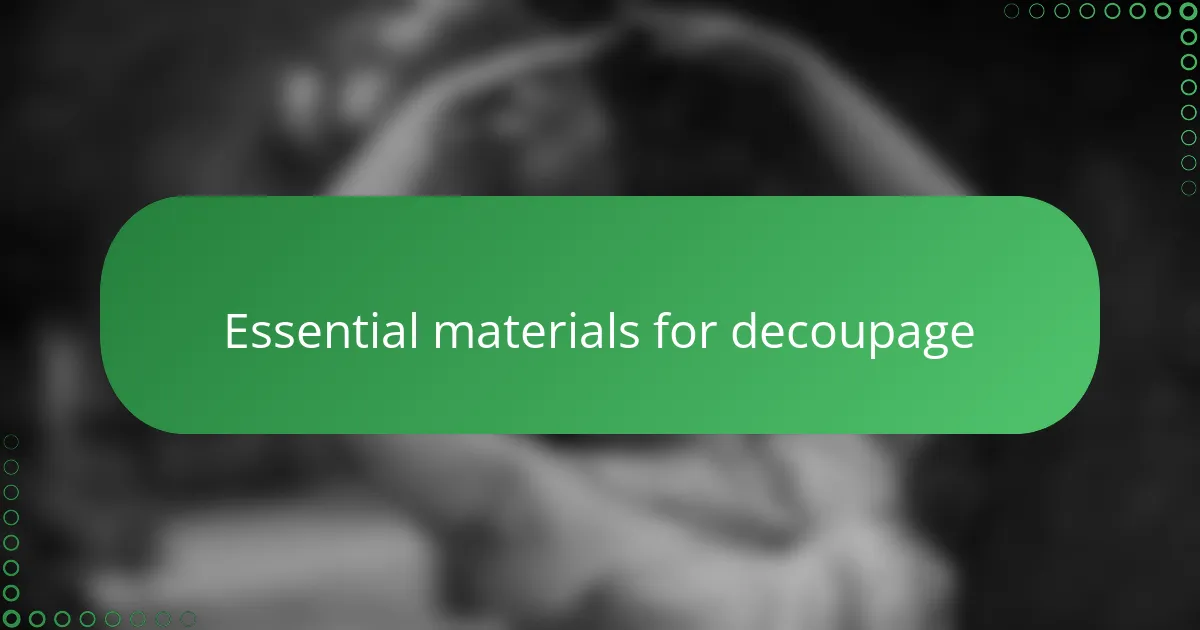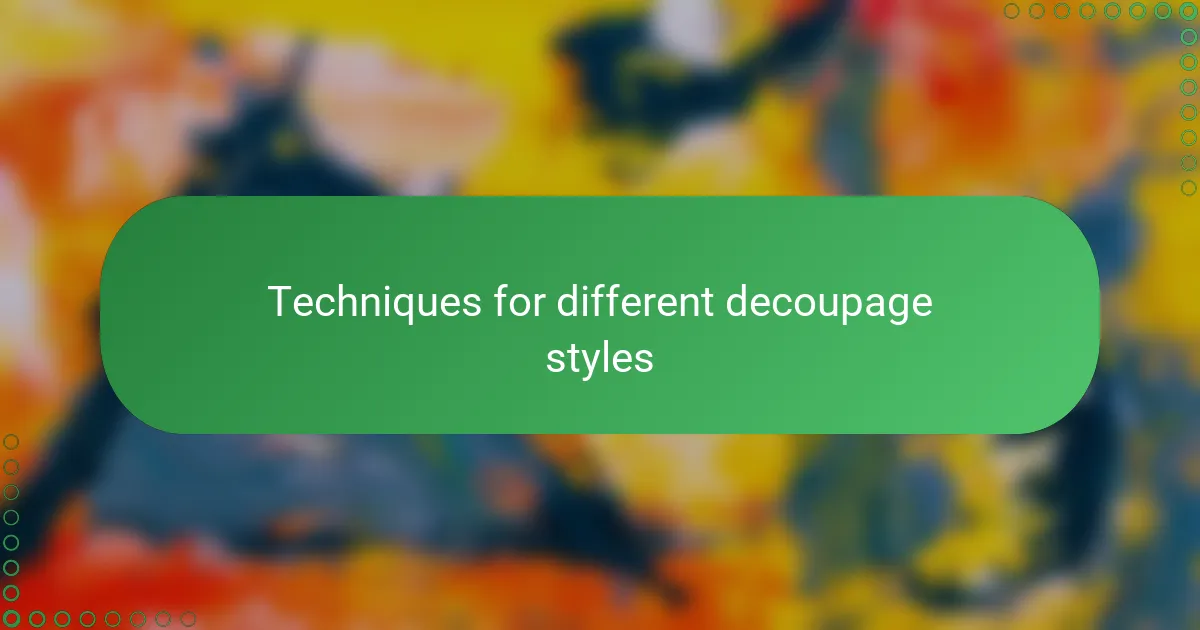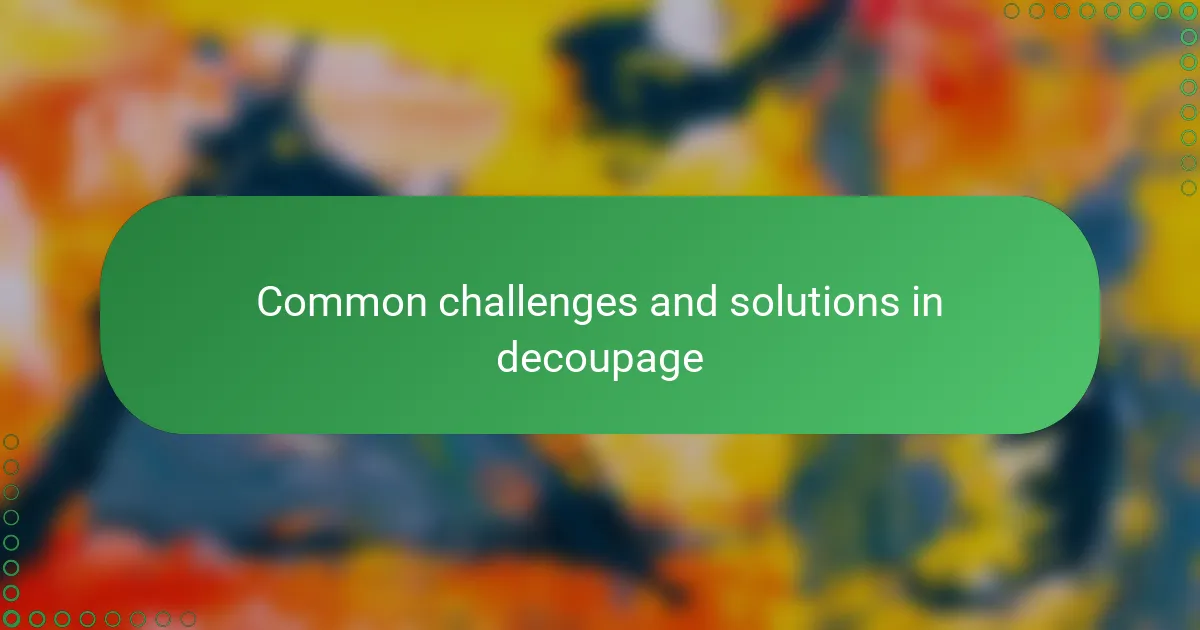Key takeaways
- Handmade paper crafts, including decoupage, offer a personal and mindful creative experience that emphasizes unique textures and imperfections.
- Exploring different decoupage styles and techniques enhances skills and appreciation for the craft, allowing for individual expression and storytelling.
- Essential materials, like appropriate paper and quality adhesive, are crucial for achieving successful decoupage projects and avoiding common issues like wrinkles and color running.
- Personal touches and experimentation with mixed media can transform decoupage pieces, making them more meaningful and unique to the creator.

Introduction to handmade paper crafts
Handmade paper crafts have always fascinated me because of their unique blend of creativity and tradition. There’s something deeply satisfying about turning simple sheets of paper into beautiful, textured artworks by hand. Have you ever felt that quiet joy when a project you crafted yourself starts to take shape right before your eyes?
From my experience, the appeal lies not only in the final product but also in the calming process of working with your hands. The subtle textures, the slight imperfections—they all tell a story that machine-made paper can never replicate. It’s a reminder that art, even on a small scale, carries our personal touch and emotions.
What I find truly inspiring is how handmade paper crafts connect us to a slower, more mindful pace in our busy lives. They invite us to pause, appreciate the tactile world, and unleash creativity in a way that’s both accessible and rewarding. Have you ever wondered why the feel of handmade paper often feels more intimate, almost alive? That’s the magic of this craft.

Overview of decoupage styles
Decoupage styles have always intrigued me because each one carries its own unique charm and story. I remember the first time I discovered vintage decoupage—there’s something magical about layering old floral prints and aged papers to create a nostalgic feel. Have you ever noticed how certain styles can transport you to a different time or place just through paper and glue?
What fascinates me most is how diverse decoupage can be. From modern geometric patterns that feel fresh and bold to the more intricate Renaissance-inspired designs, each style brings its own rhythm and emotion to the craft. It makes me wonder: which style speaks to your personality and creative spirit?
I’ve found that exploring various decoupage techniques not only broadens my skills but also deepens my appreciation for the art form itself. Whether it’s the delicate, lace-like découpage or the vibrant, collage-like approach, each style challenges you to see paper in a new way—almost like giving it a second life through your hands. Doesn’t that idea make this craft feel endlessly inspiring?

Essential materials for decoupage
When I first started with decoupage, I quickly realized that having the right materials made all the difference. Essential supplies like decoupage glue or medium create that smooth, secure bond between paper and surface, which instantly boosts confidence in your work. Have you ever tried gluing something without the proper adhesive? The mess and frustration taught me why quality glue is non-negotiable.
Besides glue, I found that choosing the right paper is a game changer. Thin, flexible papers such as tissue, napkins, or specially designed decoupage paper work best to avoid wrinkles and bubbles. I remember how disappointed I was trying to use thick cardstock—it just didn’t lay as beautifully, and the finish felt bulkier than I wanted.
Then there are the finishing touches like brushes and sealants, which I believe really elevate the project. Soft brushes help apply glue evenly without tearing delicate paper, while a clear varnish or sealer protects your artwork and adds that polished look. Have you noticed how a sealed decoupage piece almost glows? That’s the magic of finishing layers improving both durability and appearance.

Techniques for different decoupage styles
One technique that I find essential across decoupage styles is layering. For vintage or shabby chic decoupage, I usually work with multiple thin layers of aged or distressed paper, building up texture gradually. Have you noticed how this slow layering adds depth and makes the finished piece feel almost like a treasured heirloom?
When it comes to modern or geometric decoupage, precision becomes key. I’ve learned that carefully cutting crisp shapes and aligning them perfectly can transform a simple paper collage into a striking, contemporary artwork. Do you think the sharp edges and clean lines change the entire mood of a piece compared to more freeform styles?
Sometimes, I like to experiment with mixed media techniques—combining decoupage with paint or embossing. Applying a light wash of acrylic paint over a decoupaged surface can soften hard edges, creating a dreamy effect I find irresistible. Have you tried blending different methods to push your craft beyond the traditional boundaries? It’s in these experiments that I discover new styles and personal favorites.

My favorite decoupage projects
Some of my favorite decoupage projects have been small wooden boxes transformed with vintage botanical prints. I love how layering delicate floral papers turns an ordinary item into something that feels both timeless and personal. Have you ever noticed how these little details invite you to pause and appreciate beauty in everyday objects?
I also treasure creating decoupage trays using bold, geometric patterns. The crisp shapes and vibrant colors bring such energy to the piece, making it a perfect accent in my living space. Isn’t it amazing how playing with shapes and contrasts can completely change the atmosphere of a room?
One project that stands out is a mixed-media photo frame I made by combining decoupage with some paint washes. That experiment taught me how blending techniques breathes life into a project, turning it into a unique story frozen in time. Have you ever felt that thrill when an unexpected idea just clicks and your craft becomes something truly yours?

Tips for personalizing decoupage work
One tip I always swear by is choosing papers that resonate with your personality or memories. When I added scraps from an old travel journal into a decoupage piece, it instantly felt more meaningful, as if the artwork was telling my story. Have you ever noticed how a simple image or pattern can bring back a flood of emotions and make your craft uniquely yours?
I also recommend playing with textures—mixing different paper weights or adding small fabric pieces can bring surprising depth to your work. I remember hesitating at first, worried it might look too busy, but the contrast ended up making the piece stand out beautifully. Isn’t it refreshing when a small risk pays off and your project gains a new dimension?
Finally, don’t underestimate the power of personal touches like handwritten notes or subtle color washes over the paper. My favorite decoupage frame features a faint watercolor wash that softens the edges and adds warmth, making it feel handmade rather than mass-produced. Have you tried adding something unexpected that transforms your craft into a one-of-a-kind treasure?

Common challenges and solutions in decoupage
One challenge I often face in decoupage is dealing with wrinkles and bubbles beneath the paper. Early on, I learned that patience is key—slowly smoothing out the paper with a soft brush or even my fingertips helps a lot. Have you ever felt the frustration of trying to salvage a piece after it’s already glued down? It can be a little heartbreaking but, trust me, the right technique makes all the difference.
Another issue I’ve bumped into is choosing the wrong glue or using too much of it, which can cause paper to warp or colors to run. From my experience, using a specifically designed decoupage medium and applying it in thin, even layers keeps everything crisp and vibrant. I sometimes remind myself: less is definitely more in this craft.
Finally, sealing the finished piece without leaving streaks or a cloudy finish can be tricky. I’ve tried various sealants and found that spraying a clear acrylic sealer works best for me—light coats and good ventilation make the process smoother and less stressful. Have you experimented with different finishes to find one that enhances your work rather than masks it? It’s a small detail that can elevate your project from good to truly special.
